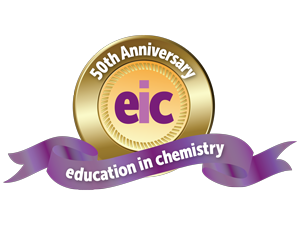January 2013
50 years on - Education in Chemistry continues to lead the way

This is a very special issue of Education in Chemistry as it marks the beginning of our 50th anniversary and a year of celebrations. We set the ball rolling with a fresh, bright, newly redesigned magazine, which I hope you will like. During the year we will see new articles and launch a brand new dynamic website. I will also share some of the golden nuggets of content from early volumes of EiC, so you can compare and contrast teaching in the 1960s with the techniques and methods we use in classes and labs today. You can find out more about this and how EiC was founded. In the article New Journal for Chemistry Teachers.
We switch between the old and the new in this issue. As Education in Chemistry is celebrating 50 years of supporting innovation and best practice in chemistry teaching, we have an interesting feature that looks at the key drivers responsible for changes to the chemistry curriculum over the decades. We then move to the cutting edge of innovative teaching practice. Simon Bates and Ross Galloway explain how engaging students in developing their own high quality assessments can make a proven contribution to their learning and understanding. I am quite sure this idea would have completely horrified teachers of 50 years ago!
With our science features, we stay at the forefront of scientific advances with a look at alternative outputs from biorefineries and developments in nanomedicine. These topics will give our students a real insight into how choosing a career in chemistry can contribute to meeting the global challenges faced by society.
The first of these features showcases an intelligent way of producing biofuels - an industry that has been seen as controversial and unethical - by persuing a 'zero -waste mindset' and producing useful molecules from its by-products.
We also find out how new methods in nanomedicine have made it possible to transport antiretroviral drugs to the core of infected cells. This new technique dramatically reduces toxic side effects and increases the effectiveness of drugs, allowing doses to be reduced. A real human interest story.
Captivating the minds of students and motivating them to take their chemistry studies further reminds me that I had a special treat back in December. I was invited to a preview of the historical RI Christmas Lectures, which were broadcast between Christmas and New Year. Absolutely fantastic! For the first time in a number of years, the lectures focused on chemistry. Unlike medieval alchemists who kept their 'magical' potions and creations secret, as the The Modern Alchemist, Peter Wothers from the University of Cambridge was truly inspirational as he revealed what happens at the extremes of our material world through an impressive range of spectacular experiments, wowing an enthusiastic young audience. You could tell how well Peter engaged with them through the variety of well thought through questions that followed each lecture. These are our chemists of the future and we need to show them at an early age how they can make a real contribution to a sustainable and financially viable future society. We can continue Michael Faraday's legacy by inspiring children to take an interest in science.
In a fitting conclusion to this special anniversary issue, Martyn Poliakoff, creator of the Periodic Table of Videos and winner of the 2012 RSC Nyholm Prize for Education has the last word. In a very poignant Endpoint, he pays tribute to the founder of Education in Chemistry, Professor Ronald S Nyholm.
Very best wishes for 2013.









No comments yet